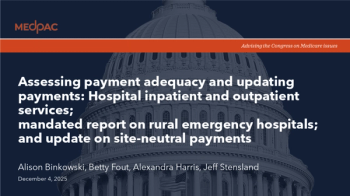
Increasing costs, declining value: U.S. health care at a crossroads
Key Takeaways
- The U.S. healthcare system is at a crossroads, requiring internal reform to avoid external policy interventions.
- Significant variation exists in commercial negotiated rates, with no correlation between healthcare costs and quality.
Trilliant Health’s 2025 report reveals rising costs, poor value, and shifting care trends as the U.S. health care system faces urgent transformation.
As Americans pay more and more for health care, but overall outcomes stagnate or get worse, the U.S. health care system is at a crossroads for change, according to one analytical firm.
Health care economic analyst Trilliant Health published
Trilliant Health suggests
“In economics, value is a measure of the benefit provided by a good or service to an economic agent. For consumer goods, value is ultimately subjective but is shaped by price, quality and convenience. In plain terms, the U.S. health care system does not provide good value to patients or society,” the report summary said.
“Said differently, the U.S. health care system is at a crossroads,” the summary said. “The choice for all health economy stakeholders is whether to implement radical and transformational change from the inside or whether to be subjected to such change by external forces.”
Trilliant Health Vice President Chief Research Officer Allison Oakes, PhD, spoke with Medical Economics about the findings and the state of American health care.
This transcript has been edited for length and clarity.
Medical Economics: A summary of the report describes the U.S health care system as being at a crossroads. Can you explain what that means?
Allison Oakes, PhD: We think the U.S. health care system, there's a number of converging forces at play, and we really feel like the health care system is on the brink of momentous change, and it's going to have to come one way or the other. So the crossroads that we feel like we're at is either market discipline or structural reform. And to break that down a little bit more in terms of market discipline with the release of all of this new price transparency data, specifically the new payer related files that started to be released in 2022, we really feel that we need to implement some change from within the health care system. So, stakeholders across the board, providers, payers, even the health insurance benefit brokers, we all need to start leveraging this data to understand who and who isn't providing health care value within the system. And for those folks who aren't providing value we need to start asking why and start asking how that can change and what we can do to reform things from within. The crossroads we're at is that we believe if we don't figure out how to do that, instead, structural reform will be implemented from outside, likely in the form of either state-based or federal-based policy interventions. So, we're at this point of, do we want to figure this out on our own? Or do we want that to be done for us in ways that are potentially less effective and less efficient, and may have worse outcomes for patients and different stakeholders?
Medical Economics: What were one or two findings that were most surprising to you?
Allison Oakes, PhD: I think one of the most surprising things and important things is just the variation that we now know to exist in commercial negotiated rates. So, this is something that we focus on in trend one, which is really focused on the issue of affordability within this country. This is something we've seen in some of our previous work as well as the
And another really important thing that we focus on is this concept of value throughout the report. Do we get out of our health care system, what we put into it? We think it's pretty clear that the answer is no, unfortunately. We have the most expensive health care system in the world, and unfortunately a lot of our patient outcomes as it relates to health and well-being in this country lag behind those other peer nations. We think that we really need to figure out how to inject a conversation around value for money within the health care system.
Another important issue related to that is, in a lot of markets, you know, if you're buying a car, you expect to get what you pay for. If you buy a Honda Civic or a Lamborghini, you're going to spend very different amounts of money. You're also going to expect those two cars to perform very differently. Another thing we uncover in the report, unfortunately, is that just because you spend more, it doesn't mean you're going to get more. Within health care, we see that prices are not correlated with quality, and we think that's a huge issue that we need to figure out how to address.
Medical Economics: Regarding price transparency, there is a section of the report that is dedicated to site settings. Can you elaborate on any trends or findings relating to hospitals and health systems, ambulatory surgical centers, and — one of the key sectors of our audience — independent practitioners?
Allison Oakes, PhD: One of our whole trends is entirely focused on care settings and the ongoing migration that we're seeing in terms of rendering care in the inpatient setting, and that care moving to the outpatient setting. So, we think there are a few things at play there.
One, this is potentially something that the COVID-19 pandemic did accelerate. In 2020, we saw decreased health care utilization across the board, which rebounded in 2021 but has been flat to declining ever since. So it does seem like there's something post-COVID. Whether it has to do with decreased trust in the health care system or concerns related to affordability, people do seem to be using traditional forms of health care, in some instances, somewhat less. But we do also see shifts in terms of where this care is being provided, and we are seeing increased utilization in outpatient settings. So, urgent care is a really good example of that. Urgent care is something that took off during the COVID-19 pandemic, but is something that has stuck around, so that's one thing that we're paying attention to.
Another thing relates to surgeries. Policy-wise, over the last couple of administrations, there's been a lot of discussion related to the inpatient only list known as the IPO list. This is a list that dictates what Medicare related procedures must be provided in an inpatient setting in order to be reimbursed. We've seen the inpatient only list kind of come and go over the last couple of administrations. But again, the Trump Administration has proposed phasing out the inpatient only list, so something that we do cover, there's a couple of examples to look for. In 2018, total knee arthroplasty was removed from the inpatient only list, and since then, the volume of inpatient-based total knee arthroplasty procedures provided in the inpatient setting has decreased by 80%. So procedures migrating from inpatient to outpatient is something that very much impacts the bottom line of your hospital-based providers. So something that we're telling our health system partners is that they really need to develop a strategy and figure out how to move into this outpatient space in order to stay competitive and relevant.
But there are some upsides too. We know that the exact same procedure when performed in the inpatient setting costs a lot more money than when it's performed in the outpatient setting. So, this migration from inpatient to outpatient care, assuming quality is held relatively constant, is actually an opportunity for us to be increasing value in our health care system. But providers have to figure out how to play in that space and figure out how they can potentially also increase care continuity as it relates to that migration.
Newsletter
Stay informed and empowered with Medical Economics enewsletter, delivering expert insights, financial strategies, practice management tips and technology trends — tailored for today’s physicians.
















